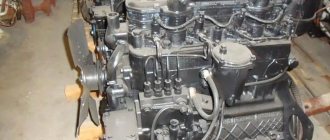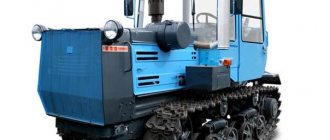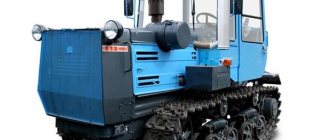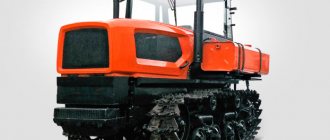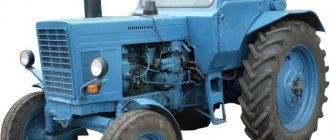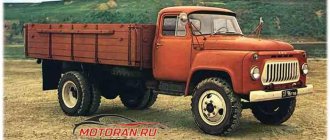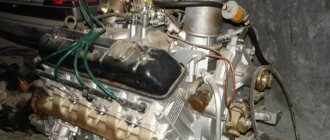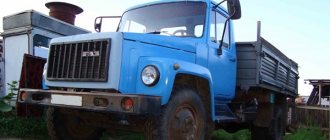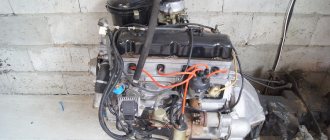Main technical parameters
Compared to the DT-14B prototype of an earlier year of production, the example of Soviet technology has wider wings and modified awning struts. The main gear housing has been structurally improved, and a pedal has been built in to connect two brakes at once.
HTZ produced only 248.4 thousand copies of the legendary tractor, partially sold abroad. The rarity serves as an exhibit in several museums. Some models that have survived to this day are successfully used and carry out agricultural activities in Moldavian, Ukrainian, Baltic and Central Asian fields and gardens.
Engine characteristics
The single-cylinder 4-stroke engine is marked with D-20 symbols and is a modified version of the reliable D-14V engine. Due to the installation of a crankshaft crank with other parameters, the shape of the side walls of the crankcase was changed. The holes for installing bearings have been widened due to increased engine speeds.
The installation implements diesel fuel injection into the combustion chamber, and the water cooling system operates effectively. The piston stroke range between the lower and upper points was expanded to 14 cm, the shape of the breather changed, the cylinder head was enlarged, and the crankcase was expanded.
In the D-20, fuel is distributed more evenly throughout the internal piston chamber, the filling index has increased, and air is better used in the working cylinder. While fuel consumption was saved, the effective pressure increased.
When the crankshaft rotates 1,600 rpm, the engine power reaches 18 hp. With. and is 13.2 kW (20 hp) at a speed of 1.800.
Among the important technical characteristics of the motor it should be noted:
- 0.2 kg of fuel is consumed every hour per horsepower,
- the fuel tank holds 45 liters of fuel,
- 14 cm is the piston stroke,
- lubrication is carried out by splashing and under pressure,
- vertical arrangement of the cylinder with a diameter of 125 mm,
- The gear pump pumps oil,
- the crankshaft rotates at a speed of 1800 rpm.
Equipping with a 3-stage air purification system increased the operating time of engine components, which is not particularly demanding on operating conditions and the quality of diesel fuel.
Cabin
The engineers decided to save on glass and metal structure, so they reduced the load on the route by eliminating the cabin. Instead, the operator at the control post is protected by an awning. Instead of an uncomfortable chair tightly fixed in the frame, a seat is installed for the operator.
Diesel fuel consumption volumes
A very economical single-cylinder engine consumes 0.2 kg per horsepower every hour. A full 45-liter tank is emptied in 12.5 working hours.
Weight and dimensions parameters
The car was produced in two modifications. The low version with a clearance of 30.8 cm and a height of up to 1.8 m is designed for field needs. The tall model with a clearance of 51.5 cm and a height of 1.231 m is designed for garden events.
Models DT-75 and DT-25 were designed on the basis of a unit weighing 1,560 kg.
A mounted system with a long canopy (up to 3 m) was mounted on the DT-20 tractor to protect the operator from rain and scorching sun. The frame was fixed on two wings with special brackets.
Chassis and hydraulic system
Depreciation of the chassis is achieved thanks to the front wheels, rigidly connected to the axle of the same name, balancing vertically. A mechanical lever is built in to control the disc friction clutch transmission. With reverse engaged, the mirror-controlled tractor moves backwards at a speed of 16 km/h.
To interface and transfer other machines and equipment into working position, the tractor is equipped with a separate-unit hydraulic linkage system, consisting of a hydraulic drive and a lever mechanism. The design elements of the hydraulic drive include:
- gear pump mounted on the motor and rotating from the balancing shaft,
- power cylinder mounted at the rear,
- oil tank,
- spool valve next to the operator's seat.
Rubber and metal pipelines are used to connect hydraulic drive units.
Transmission, steering and brake control
In the manual transmission of the car, 4 gears are intended for driving forward, and 3 are engaged in reverse remotely, from the operator’s cab. The tractor moves at a maximum speed of 17.65 km/h.
Torque is transmitted to the gearbox from the engine through a constantly engaged dry single-plate clutch with a mechanical drive. It turns off when pressure is applied to the pedal in the tractor driver's cab.
The driving rear axle of the tractor has two-satellite inter-wheel bevel differentials, leaving the inner wheel in place during a turn. The maneuverability of the vehicle is increased thanks to a system of separate brakes combined with a differential.
Engine 1D-20. 1D20 engine
Engine 1D20
Select category:All Electromechanics» Fans»» Axial fans»» Centrifugal fans»» Electric fans» Rectifier devices» Generators»» Spare parts for ECC generators» Hydraulic connector valves» Two-machine units» Charging and charging-starting devices» Compressors»» Spare parts for compressors » Pumps» Synchronous frequency converters (PSC)» Heat exchangers» Electric motors»» Stepper motors Diesel engines» Diesel engines» Spare parts for special. equipment and vehicles» Spare parts for diesel engines Electrical equipment» Ammeters and voltmeters» Switches and buttons» Surface temperature sensors» Coils for relays, contactors, starters, magnets» Contactors» Contacts of electrical devices» Magnetic starters» Heaters» Switches»» PC switches 12 »» Switches of the PK-16, PK-25 series»» Switches of the PKU-3 series»» Switches of the UP series» Flow regulators» Relays»» Time relays»» Voltage relays»» Air flow relays»» Intermediate relays»» Thermal relays» » Current relay»» Frequency relay»» Pressure relay»» Indicative relays»» Devices and protection relays»» Solid state relays» Pressure alarms» Temperature alarms» Transformers» Electromagnets» Electrical installation products»» Boxes»» Socket boxes»» Cabinets» DC devices current" AC devices" Digital devices" Panel recorders" Filters"" Hydraulic filters""Ion exchange filters Domestic electronic components"Diodes"Capacitors"Microcircuits"Fuses"Fuse link"Selsyns, tachogenerators"Transistors Computer technology"Magnetic heads"Disk packages for ES5066M, ES5056M" Tape puncher PA150M" Printing device TS7080" Heat exchangers "Spare parts for the printing device ES7040 Special types of papers" Paper Electrovacuum products" Generator tubes "Magnetrons" Radio tubes Spare parts for military-industrial complex" 125 RK "Pechera" "Ampoules" Chokes" Bearing and" Selsyn" Heat exchangers
Results per page: 5203550658095
Engine 1D-20
Select category:All Electromechanics» Fans»» Axial fans»» Centrifugal fans»» Electric fans» Rectifier devices» Generators»» Spare parts for ECC generators» Hydraulic connector valves» Two-machine units» Charging and charging-starting devices» Compressors»» Spare parts for compressors » Pumps» Synchronous frequency converters (PSC)» Heat exchangers» Electric motors»» Stepper motors Diesel engines» Diesel engines» Spare parts for special. equipment and vehicles» Spare parts for diesel engines Electrical equipment» Ammeters and voltmeters» Switches and buttons» Surface temperature sensors» Coils for relays, contactors, starters, magnets» Contactors» Contacts of electrical devices» Magnetic starters» Heaters» Switches»» PC switches 12 »» Switches of the PK-16, PK-25 series»» Switches of the PKU-3 series»» Switches of the UP series» Flow regulators» Relays»» Time relays»» Voltage relays»» Air flow relays»» Intermediate relays»» Thermal relays» » Current relay»» Frequency relay»» Pressure relay»» Indicative relays»» Devices and protection relays»» Solid state relays» Pressure alarms» Temperature alarms» Transformers» Electromagnets» Electrical installation products»» Boxes»» Socket boxes»» Cabinets» DC devices current" AC devices" Digital devices" Panel recorders" Filters"" Hydraulic filters""Ion exchange filters Domestic electronic components"Diodes"Capacitors"Microcircuits"Fuses"Fuse link"Selsyns, tachogenerators"Transistors Computer technology"Magnetic heads"Disk packages for ES5066M, ES5056M" Tape puncher PA150M" Printing device TS7080" Heat exchangers "Spare parts for the printing device ES7040 Special types of papers" Paper Electrovacuum products" Generator tubes "Magnetrons" Radio tubes Spare parts for military-industrial complex" 125 RK "Pechera" "Ampoules" Chokes" Bearing and" Selsyn" Heat exchangers
Device
The rear-wheel drive tractor is of the “classic” type with a single drive axle. The unit uses widened rear tires with reduced pressure and deep tread. The front axle tires have a smaller diameter.
The adjustable parameters of the chassis made it possible to adapt the car to a wide variety of activities. The level of performance and the magnitude of the dynamic characteristics are influenced by the wheel track, as well as ground clearance, longitudinal base and weight with a hitch.
DT-20 has an important feature: the wheels can be swapped and the seat, pedals and steering wheel can be rearranged.
The brake system of the unit is equipped with pedal control. Uses a hydraulic attachment and equipment system, a dependent power take-off shaft and a replaceable pulley. With the canopy installed, the load on the wheelbase changes.
For Soviet times, the unit was distinguished by its most efficient operation and minimal comfort for the tractor driver. Rare models had an awning, and the cabin was completely absent, as was the frame, unlike modern models.
The rear wheels are driven, and the pair is firmly attached to the front axle. The control involves band-type pedal brakes with separated functions.
The tractor has the ability to adjust ground clearance and interface with attachments and trailers.
Description
This is an extremely reliable liquid-cooled power unit that uses direct fuel injection. The diesel engine is easy to use, reliable and durable. Let us note the unpretentiousness of this power unit regarding the quality of the fuel used.
One of the features of this power unit is the use of rolling bearings rather than plain bearings in the crankshaft. This design made it possible to somewhat simplify the operation of this power unit, ensuring its maximum reliability.
The displacement of the UTD 20 engine is 15.9 liters, due to which the engine has excellent traction characteristics, which allows it to be used in tanks and heavy infantry vehicles BMP-1. Subsequently, this power unit was used with minimal changes on KamAZ trucks and other special equipment. This solution can significantly increase the reliability of the trucks used, and the engine itself is easy to repair and has excellent reliability.
UTD 20 engines do not have a fuel drain system, the so-called return line, which is typical for most other diesel engines intended for installation on heavy special equipment or in BMP-1 military vehicles.
We note that there is no engine starting system in the cold season, which somewhat complicates the operation of the car in winter, when problems with diesel fuel freezing in the engine may occur. It must be said that a similar system appeared on a modification of this engine under the designation UTD-20S1. This engine uses torchless nozzle heating of the intake air, which allows the engine to be started even at ambient temperatures below minus 20 degrees.
The power unit itself is made of high-quality metal alloy, which is resistant to overheating. Therefore, it is possible to operate this power unit under conditions of increased loads.
User manual
Maintenance
Uninterrupted and long-term operation of the tractor is ensured by timely and high-quality technical inspections and maintenance procedures. The car is cleaned of dirt, refueled and lubricated. The condition of systems and units is regularly checked, and any detected defects are eliminated.
The maintenance rules provide:
- periodic maintenance measures carried out after certain periods of operation (duration is calculated based on the amount of fuel consumed and the duration of engine operation),
- Shift care is performed at the start and during team breaks.
Maintenance of equipment operating with the unit is carried out regularly according to the instructions in the operating manual.
Table. Regular maintenance of the DT-20 tractor
Conservation
It is not advisable to use DT-20 in winter. The engine preservation procedure involves draining oil, fuel and spent fuel. The entire machine is cleaned and washed, the mechanisms and elements are dried and lubricated.
Basic problems, troubleshooting methods
The motor does not turn on:
- low quality or lack of fuel and oil,
- the fuel or air filter is clogged,
- The fuel pump does not work.
The hydraulic system does not work:
- not enough oil
- hydraulic pump is switched off,
- The safety valve is jammed.
Starter failure:
- weak contact of the magnetic switch,
- battery is low,
- wire break,
- short circuit.
If the brake system fails, it is necessary to replace the discs or reduce the pedal stroke.
Modifications
Among the modifications, the only modification that can be noted is the UTD-20S1 model, which was a modernized version of the power unit, equipped with a return line, which made it possible to fully prepare the engine for winter, drain fuel from it and carry out high-quality preservation. Among other things, the presence of a fuel heating system in this modification made it possible to operate the vehicle even in the cold season. There were no more significant differences between these two engine modifications.
Maintenance
The technical conditions for repairing the UTD-20 engine indicate that maintenance of the power unit system is carried out at certain intervals. The work that is carried out during this procedure is relatively simple. This fact greatly simplifies the use of the motor.
The oil is changed every 1000 operating hours. When the unit has operated for 3000 hours, the fuel system should be cleaned. You will also need to open the cylinder head. The valve system at this stage requires high-quality cleaning.
No other service work will be required. If the engine will not be used in winter, the fuel must be drained, as well as other technical fluids. However, this is difficult to do if there is no return line on the motor. It is better to seek help from professionals.
Scope of application
The tractor is excellent for working on vegetable plantations and horticultural farms; on the cultivation of flax and cotton; in the vineyards; on livestock farms.
“DT-20” was used with trailed and mounted agricultural implements, relevant specifically for these areas of agriculture, for transporting goods, harvesting and auxiliary work. It was also used to drive a variety of stationary machines and mechanisms.
Too light and not powerful enough for full-fledged row-crop work, the DT-20 tractor, however, successfully cultivated and inter-row weeded crops; their chemical treatment - spraying, fertilizing.
It was widely used for harvesting, making hay, and removing vines and fruits. The DT-20 tractor was widely used in vineyards with one and a half meter row spacings.
A significant increase in functionality of this tractor was given by the above-mentioned possibilities of adjusting the track (both front and rear wheels); changes in ground clearance, grip weight and longitudinal base.
Malfunctions
| FAULT | CAUSE |
| The engine refuses to start. | The reason for this is improper operation of the fuel system. It is necessary to determine whether fuel is supplied to the cylinders, after which you can open the engine and conduct an in-depth diagnosis of engine damage. |
| There was a leak from under the valve cover gasket. | In this case, the repair consists of opening the motor and replacing the damaged gasket. |
| The engine smokes and consumes a lot of oil. | The reason is burnt-out pistons and rings, which leads to a significant increase in oil consumption. |
| The engine has lost some of its power and does not hold speed well. | The reason may be a failure of the high-pressure fuel pump, which does not provide high-quality fuel supply. This is a non-repairable element and requires its complete replacement. |
History of creation
Starting a review of the UTD-20 engine, it should be noted that this engine has a long history. Thus, during the war, the V-2 engine running on diesel fuel was not put into mass production. Then, in the 50-60s of the last century, a series of unified tank engines, which were called UTD, were developed on its basis.
The main one in this series was the four-stroke UTD motor, which had a dimension of 15 x 15. This feature made it possible to increase the cylinder power and rotation speed. The height of the V-type has also been reduced. The design features a one-piece crankcase. It is equipped with rolling bearings. This also increased its rigidity. Connecting rods were fixed in the crank mechanism, which made it possible to reduce the longitudinal dimensions of the motor.
The configuration of the UTD combustion chamber has changed compared to the V-2, but the valve mechanism remains the same. It was launched using spur gears. They have become easier to make. Moreover, such elements of the system have proven their high reliability compared to beveled ones. The designers of the presented enterprise developed prototypes of engines with 12, 10, 8 and 6 cylinders. Further modifications were created with a large number of these elements. Moreover, both supercharged and naturally aspirated varieties were developed.
The technical process for assembling the UTD-20 engine has undergone a number of changes. As a result, modifications with a power of 150-1200 kW appeared. At the same time, the specific fuel consumption was 240 g/kWh. The engines were installed on armored self-propelled vehicles. Their service life was at least 1000 hours. In deposited commercial versions, this figure was 15-20 thousand hours.
